 Image search results - "warrior" Image search results - "warrior" |

Warrior monk procession 僧兵行列
|
|

It is unusual or unique to see such a procession for Setsubun. 僧兵行列
|
|
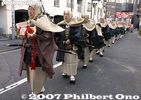
In 1951 when they were rebuilding the temple destroyed by the war, they found some items which were supposedly used by a warrior monk. 僧兵行列
|
|

So from 1953, as part of the Setsubun ceremonies on Feb. 3, they started this procession of people dressed as warrior monks.
|
|

They are not real warrior monks. Monks do not go to battle as they once did centuries ago. Also see the video at YouTube. 僧兵行列
|
|

Rear view
|
|

Warrior monks entering Hosenji temple. 僧兵行列
|
|

This man must be the leader.
|
|

Blowing a conch shell. One of the signals of battle.
|
|

The warrior monk costume is interesting. The collar makes them look bigger and more fearsome. 僧兵行列
|
|

The procession started at 3:30 pm at a nearby shrine.
|
|

They arrived Hosenji at around 4 pm.
|
|
|
|

Memorial service 柴燈大護摩供
|
|
|
|
|
|

Instrument players
|
|
|

柴燈大護摩供
|
|

Setting afire
|
|

柴燈大護摩供
|
|

Sign near Bannaji temple saying that the warrior procession would start at 7 pm.
|
|

On the way to Bannaji temple, this statue of the Ashikaga lord.
|
|

Gate to Bannaji temple. It is actually an arched bridge.
|
|

Gate to Bannaji temple.
|
|

Behind the gate to Bannaji temple.
|
|

After going through the gate, there's this path to the temple hall. Now lined with food stalls during the festival.
|
|

Plum trees
|
|

Bannaji temple main hall. National Treasure built by Ashikaga Takauji's father. A rare example of a main temple hall from the Kamakura Period.
|
|

Carrying wooden boxes of beans.
|
|

At one point along the procession route (a major road), there was a rest station where they served free ama-zake (sweet sake). The hot drink warmed us up.
|
|

On Feb. 3, the Yoroi Toshikoshi Shuko festival is held in the evening with a warrior procession going to Bannaji. Start of the warrior procession consisting of local children, men, and women. The procession started at Orihime Kominkan. 織姫公民館
|
|

Since it is held at night in the middle of winter, dress warmly.
|
|
|

Going over the arched bridge at Bannaji temple.
|
|
|
|
|
|
|
|
|

Yoroi Toshikoshi Shuko festival, Ashikaga, Tochigi.
|
|
|
|

Once in a while, they would shout a war cry.
|
|
|
|
|
|
|
|

Yoroi Toshikoshi Shuko festival, Ashikaga, Tochigi.
|
|
|
|
|
|
|
|
|
|
|
|
|
|
|

I saw at least two foreigners also dressed up as well.
|
|
|
|
|
|

Yoroi Toshikoshi Shuko festival, Ashikaga, Tochigi.
|
|

They all entered Bannaji temple by crossing the narrow arched bridge.
|
|
|
|
|
|
|

Within the grounds of Bannaji temple, they all gathered at this small outdoor stage.
|
|

After a few speeches, they got boxes of beans and threw them at us, but only the people up front got hit with beans.
|
|

The bean throwing was very short, both time-wise and distance-wise.
|
|
|
|
|
|

The bean-throwing was disappointing at Yoroi Toshikoshi Shuko festival in Ashikaga, Tochigi. Few beans and they hardly reached anybody.
|
|

Japan's oldest school.
|
|
|

Statue of Lord Ii Naomasa (井伊 直政 1561-1602 ) in front of JR Hikone Station in 2007.
|
|
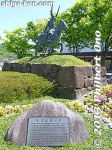
Statue of Lord Ii Naomasa (井伊 直政 1561-1602 ) in front of JR Hikone Station. One of the four great generals (徳川四天王) who helped Tokugawa Ieyasu win the Battle of Sekigahara (関ヶ原合戦) in 1600 to unify Japan and become shogun.
|
|
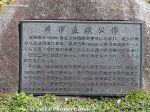
Ieyasu rewarded Naomasa with the strategic domain of Hikone (mainly Hikone, Maibara, Nagahama, Taga), making Naomasa the first Hikone daimyo (feudal lord 大名) in Omi Province (近江国).
|
|
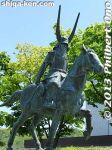
Sawayama Castle (佐和山城) came with the domain, but Naomasa did not like it, being outdated and the former castle of Ishida Mitsunari (石田 三成) who lost at Sekigahara.
|
|
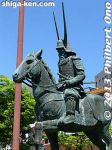
Naomasa planned to build a new castle, but died in 1602 from an old Sekigahara gunshot wound before construction began.
|
|

In front of Hikone Station, welcome banners for Hikone Castle's 400th anniversary in 2007 surround a statue of Ii Naomasa.
|
|
|
|
|
|